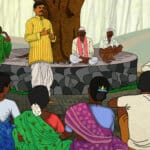Article 21 of the Indian Constitution is a fundamental right that declares that “no person shall be deprived of his life or personal liberty except according to the procedure established by law.”
The Indian judiciary has broadly interpreted this provision to include various aspects of human life that go beyond mere physical existence. It is the “heart” of the Indian Constitution and contains a plethora of rights.
Article 21 establishes two fundamental rights:
- the right to life
- the right to personal liberty.
The right to life is more than just the right to survive. It also entails being able to live a full, dignified, and meaningful life. The freedom to act, think, speak, and express oneself without undue interference or restraint from the state or any other authority is defined as the right to personal liberty.
The main goal of Article 21 is that when the State takes away any person’s right to life or liberty, it should only be done in accordance with the procedure established by law. This implies that this right is only available against the State. The term “state” refers to not only the government but also government departments, local bodies, legislatures, and so on. Any private individual infringing on the rights of another does not constitute a violation of Article 21. In this case, the victim’s remedy would be under Article 226 or under general law.
Important Case Laws:
Judicial intervention has ensured that the scope of Article 21 is not narrowed and restricted. Several landmark decisions have contributed to its expansion. Among the significant cases are:
- AK Gopalan Case (1950): Prior to the 1950s, Article 21 had a somewhat limited scope. In this case, the Supreme Court ruled that the phrase “procedure established by law,” as used in the Constitution, embodied the British concept of personal liberty rather than the American concept of “due process.”
- Maneka Gandhi vs. Union of India Case (1978): This case overturned the Gopalan case decision. The Supreme Court ruled in this case that Articles 19 and 21 are not watertight compartments. The concept of personal liberty in Article 21 has a broad scope, including many rights, some of which are embodied in Article 19, providing them with “additional protection.”
- Francis Coralie Mullin vs. Administrator, Union Territory of Delhi Case (1981): The Supreme Court ruled in this case that “the right to life is not limited to physical existence, but it also includes the right to live with human dignity.”
- Olga Tellis vs. Bombay Municipal Corporation Case (1985): The Supreme Court recognized in this case that “the right to livelihood is born out of the right to life” and that “the eviction of pavement dwellers without providing them with alternative housing would amount to deprivation of their life.”
- MC Mehta vs. Union of India Case (1987): The Supreme Court ruled in this case that “the right to life includes the right to enjoy pollution-free water and air,” and that “the State has a duty to protect and improve the environment.”
- Vishaka vs. State of Rajasthan Case (1997): In this case, the Supreme Court established guidelines for preventing workplace sexual harassment and stated that “the right to life includes the right to work in a safe environment.”
- PUCL vs. Union of India Case (1997): In this case, the Supreme Court ruled that “the right to life includes the right to privacy” and that “unauthorised telephone tapping violates this right.”
- Selvi v. State of Karnataka Case (2010): In this case, the Supreme Court ruled that “the right to life includes the right against self-incrimination” and that “compulsion of narco-analysis, polygraph, or brain mapping tests violates this right.”
- Justice KS Puttaswamy vs. Union of India Case (2017): The Supreme Court ruled in this case that “the right to life includes the right to informational privacy” and that “the Aadhaar scheme does not violate this right as long as it is used for legitimate purposes.”
Right to Education
Article 21 A is a part of Article 21 that mandates free and compulsory education for all children aged six to fourteen. The Constitution (Eighty-sixth Amendment) Act of 2002 included this provision. It imposes a duty on the state to provide such education, as well as on parents to send their children to school.
Article 21 B is another part of Article 21 that establishes a National Commission for Elementary Education to monitor and supervise the implementation of Article 21 A. This was also added by the Constitution (Eighty-sixth Amendment) Act, 2002.
Article 21 C is another part of Article 21 that empowers the State to enact any law for free and compulsory education for children, notwithstanding any inconsistency with the fundamental rights guaranteed by Articles 14, 15, and 19. The Constitution (Eighty-sixth Amendment) Act of 2002 also included this provision.
Conclusion
Article 21 of the Constitution of India is a vital and versatile provision that protects the right to life and personal liberty of every citizen in India. The judiciary has interpreted and expanded it to include various aspects of life that make it meaningful, comprehensive, and worthwhile. It also requires the government and parents to provide free and compulsory education to all children. This Article is the heart and soul of the Indian Constitution, as well as the source of numerous other rights and liberties. It reflects the vision and values of the Constitution’s founding fathers, who wished to establish a democratic republic that valued human dignity and equality.
Other related posts:



